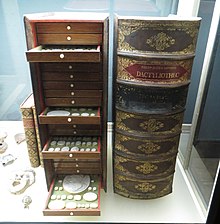Dactyl library
A Daktyliothek ( Greek: daktyliothekē , ring container, ring box; also Daktylothek ) was originally a collection of antique (seal) rings. Later the term was mainly used for a collection of impressions of cut jewelery or precious stones ( gems or cameos ), whereby the collection can also contain originals.
In the 18th century, replicas and impressions in plaster of paris , sealing wax, sulfur or wax of glyptic products - that is, of the plastic processing of gemstones and precious stones, rock crystal and similar types of stone with the help of cutting and grinding devices - enjoyed increasing popularity. They were cheaper than the originals with their higher material value, which also had a high collector's value due to their rarity. These replicas were especially noted for their informative value about the art and culture of the respective epoch. Many important statues had not yet been rediscovered or recovered - and yet the collector already knew them from an ancient illustration carved in stone. In the enlightened bourgeois world of the second half of the 18th century and at the beginning of the 19th century, the possession of a collection of originals or replicas of works of the glyptic was to a certain extent a testimony to belonging to the educated social class. - In 1832 it became known that the supposedly antique gems in the collection of Prince Stanislaus Poniatowski (1754–1833) were pieces that had been made by contemporary gem cutters. As a result of this scandal, interest in gems (and their prints) decreased.
The oldest dactyl library in Rome came from Scaurus . Also Mithridates had a rich Daktyliothek that his conqueror Pompey into Rome Capitol was put and the Jupiter consecrated.
The most important collections today include the great cameos of inestimable value in the National Library in Paris , in the Hermitage , in the Uffizi , in the Kunsthistorisches Museum in Vienna, Naples and The Hague.
The Daktyliothek by Philipp Daniel Lippert (1702–1785) in Dresden is particularly well known in Germany . The collection of King Friedrich II (Prussia) , who acquired the collection of Baron Philipp von Stosch , is also of great importance . The Lippert Daktylothek was very expensive because of its size and therefore not affordable for everyone. There are therefore also dactylotheques of smaller size. Grand Duke Carl August von Sachsen-Weimar acquired the Lippert Dactyliothek for 200 thalers and informed his friend Goethe of this on September 16, 1825.
literature
- Valentin Kockel , Daniel Graepler (ed.): Daktyliotheken - gods and Caesars from the drawer. Antique gems in impression collections from the 18th and 19th centuries. Biering & Brinkmann, Munich 2006.
Web links
- Antique gems in impression collections from the 18th and 19th centuries
- Jewelery dictionary by Prof. Leopold Rössler
- Gems, "enough of what is excellent and desirable"
- http://www.harrassowitz-verlag.de/dzo/artikel/201/417_201.pdf?t=1264419398
